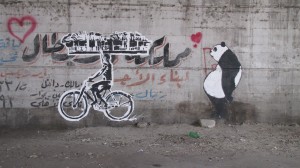Creativity Overflowing the Streets of Cairo
All photos by the author.
For the past month, artists and activists have taken the streets of Cairo by storm. From pictures of the martyrs to written slogans, you can feel the creativity in the air.

It all started in late March. A portrait of one of the martyrs of the Revolution was painted on the wall of a public restroom, only to be removed less than a month later. Because of that incident, the Mad Graffiti Weekend was organized on the weekend of May 20 to 21. It hasn’t stopped since.
From my first morning back in Cairo, I witnessed a huge amount of art in the streets — under bridges, in small alleys, on highways and more. I started noticing small graffiti works scattered around pretty much everywhere, but also some huge murals in certain areas of the city.
The art attracted media attention. The Mad Graffiti event was organized by Aida El Kashef, a film director who was arrested in late May along with two other artists, Mohamed Fahmy (aka Ganzeer), a graffiti artist, and musician Rahman Amin (aka NadimX). The three activists were hanging posters to encourage people to attend the “Second Day of Rage” (the first one is what sparked the revolution in January). They were released shortly after their arrest.

Some of the art is very political, while some other works are more socially oriented. There are also funny comics. This is something that makes me love Egypt. Even in the most critical and dangerous circumstances, we never forget our sense of humor. I walked around various neighborhoods to look at the art. I was really impressed by the quality of a few pieces, but as a whole, it wasn’t fancy. It was, nevertheless, heartening.
A lot of what I found were stencils of the martyrs. Ganzeer, one of the main actors in the event, told Al Masry Al Youm, an Egyptian independent newspaper, that he wishes to paint all 850 martyrs on the walls of Egypt.
Some of the art represented the former president, Mubarak, in a way or another. He is always portrayed in a pejorative manner. When I stepped out of the car to visit the site of the Mad Graffiti event, a parking attendant noticed my camera and immediately directed me towards one particular artwork. Apparently, a lot of people have been recording the event and he knew exactly what I was looking for. He showed me the following artwork, which he called “the Joker,” representing the king on a playing card.
This following image took me a while to figure out, because I never played chess. Once I understood it, I found it very sharp. It is located on the outside wall of the former American University of Cairo’s library (in the downtown campus, adjacent to Tahrir Square, the site of the largest demonstrations).

One of the pieces that became well known is a boy on a bicycle. The boy is carrying a tray of bread, a scene that we often see in Cairo. Only here, he is opposed by a life sized tank. Next to this scene is a painting of a black and white panda. The symbol of a street artist who operates under the name “Sad Panda,” this depressed, political animal is present on lots of walls around the city (it could possibly be a visual reference to a series of infamous commercials in Egypt for Panda brand cheese, which featured an angry Panda knocking over the cart of a family who refused to buy his brand).

Next to the Faculty of Fine Arts, I found an entire wall divided into different paintings. Although I personally didn’t find them all very good, some exceeded my expectation.

Some of the artwork I deemed naïve. Actually, what I found next to Tahrir Square didn’t look like street art or graffiti, it started to look like vandalism. At first I was taken aback, because it surrounds some big governmental institutions, schools and a university. But looking closely, I started to appreciate the small scribbles and sketches.

What touched me the most is that the sentence “I love Egypt” was written in Arabic, English, French, Italian, Russian and Greek. People also wrote how proud they were of their country. I also found “I was here” several times. People are recording their presence in the streets of Egypt in all possible ways. Their mark is there, hopefully to stay.

Every couple of days, I discover a new piece that wasn’t there the day before. The work from the Mad Graffiti Weekend is still on the walls of Cairo, which is a good sign. Is it the beginning of a true freedom of speech? Will it impact the Egyptian art scene? It is still too early to tell, but it is a promising start.
Check back later this week, when Mehri Khalil reports on visits to Townhouse Gallery and the Egyptian National Museum.









I found this article extremely interesting and the pictures of the graffiti amazing! the street art is full of so much feeling and is really telling the story of what has been happening in egypt. fascinating!